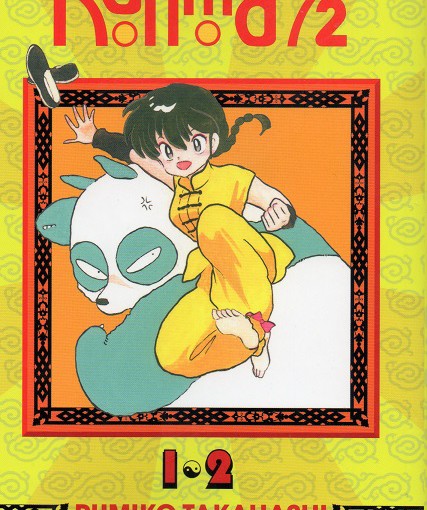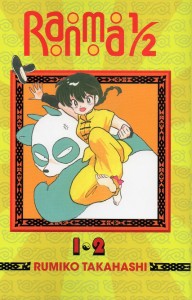Manga Review: Ranma 1/2 by Rumiko Takahashi
Soun Tendou, a widowed martial arts instructor in the Nerima suburb of Tokyo, has three daughters: gentle Kasumi, cunning Nabiki and fiery Akane. They are surprised to learn one day that their father made an agreement with his old friend Genma Saotome to marry one of them to Genma’s son Ranma. Akane is unimpressed with the old-fashioned idea of an arranged marriage, especially as it turns out Mr. Tendou has never actually seen Ranma and knows nothing about him.
Imagine their surprise when a panda shows up at their door with a young girl in tow, who claims her name is Ranma Saotome! Akane immediately takes to her fellow martial artist, who is endearingly shy. However, when Akane walks in on Ranma in the bathtub, it turns out he’s male after all! Also, the panda is actually Genma Saotome. A couple of months ago, the two of them fell into cursed pools in a training exercise gone horribly wrong. As a result, they change forms when splashed with cold water, returning to normal when exposed to hot water.
Soun decides that the engagement is still on, so Kasumi and Nabiki immediately dump the arrangement on Akane. Citing Akane’s difficulties with boys, Nabiki points out that Ranma is a girl some of the time. Akane objects, and Ranma makes a rude remark that gets him hit with a table.
The engagement stands, and the quarrelsome couple must learn to deal with each other while coping with other transformees, wacky martial artists, a love dodecahedron and the continuing fallout of Genma and Soun’s terrible life choices.
This romantic martial arts comedy manga ran in Shonen Sunday from 1987-1996, and spawned an anime series, several movies and OAVs, and relatively recently a live-action TV film. It (particularly the anime) was a gateway series for many American fans in the early 1990s.
Much of the comedy in the series comes from the fact that Ranma is a very macho young man, who is exaggeratedly masculine and often trapped in a short, busty girl’s body. Raised in relative isolation by his none-too-socially-ept father, Ranma has heroic instincts but is rude and uncultured, often setting off Akane with unthinking insults. Over the course of the series, Ranma learns how to use his female form to his advantage, but never fully reconciles himself to it or the social role it’s supposed to play.
Akane also struggles with social roles. She’s very attractive (though you will need to take the story’s word for it) which has caused her problems with boys and other perverts, and exacerbated her hair-trigger temper. She’s amazingly bad at most traditional feminine domestic skills, and her best strong point, her martial arts ability, is routinely overshadowed by Ranma and his opponents. Since both the main characters are stubborn and cantankerous, even as they slowly fall in love they can’t admit it.
It should be noted here that most of the people in this series are jerks to one degree or another. Much of the nonsense that drives Ranma and Akane apart even as they draw closer together could have been avoided if someone hadn’t decided to be a jerk at the wrong moment. Even normally adorable Kasumi has her off moments.
Overall, the series is a lot of fun, with enjoyable art, funny jokes and silly characters. And once in a while some tense action. Like many long-runners, it sags some in the middle (the “introduce new wacky character” gimmick only works so many times) and the ending doesn’t really resolve anything. But hey, it’s a comedy.
Given the premise, there’s quite a lot of nudity in the series; if your child is too young to be shown that girls have nipples, they’re too young to be reading this. (One of the running jokes is that Ranma has no body modesty.)
More problematic is that “girls hitting boys that make them angry, even by accident, is hilarious” is driven into the ground in this series. Akane is the worst offender, being the female lead, but most of the other girls are just as awful proportionate to their screen time. Even by the 1990s, social attitudes were shifting, and by now it can make for some uncomfortable reading. Also, some of the things Genma does to Ranma as “martial arts training” would get him arrested for child abuse, and the perverted old master Happosai is treated as an annoyance rather than a sexual offender.
The series does not so much deconstruct Japanese gender roles so much as poke them repeatedly with a sharp stick.
The anime is also good (and has a lot of nice music) but relies heavily on filler (episodes that are anime-only and often have continuity issues) and ends when Ranma’s long-lost mother shows up (about 2/3rds of the way through.) Later season have poorer animation quality as production was moved to cheaper studios.
Viz originally brought Ranma 1/2 over using the flipped-artwork process to make it read left-to-right; between that and their then deliberately slow release of volumes, it took forever to come out in the U.S. (so the anime was a bigger influence on the fanfiction.) It’s now being reprinted in the otaku-friendly right-to-left format, with each volume containing two of the Japanese volumes.
In Volume 1-2, the one to hand, the main characters are introduced. Ranma is assigned to the same school as Akane, and we meet Dr. Tofuu (a practitioner of traditional Japanese medicine and Akane’s first crush) and Tatewaki Kunou, the belligerent and amorous upperclassman who’s done the most to cause Akane’s attitude towards boys. Kunou starts a feud with male Ranma while falling in love with female Ranma (this does not stop him hitting on Akane, and Kunou never fully grasps that the two Ranmas are the same person.)
Just as it looks like Ranma and Akane’s relationship might be warming up, Ranma’s martial arts rival Ryouga appears. Although he’s very strong, Ryouga has a terrible sense of direction, and is cursed to turn into a cute little piglet. Ryouga blames Ranma for that last thing (for the wrong reasons) and is bent on revenge. He also falls in love with Akane. In this first story arc, Ryouga is a clear “heel” but eventually has the most positive character development of anyone in the series.
Ranma and Ryouga have reached something of a stalemate when a new challenger appears, Kodachi Kunou (sister of Tatewaki), who is a mistress of Martial Arts Rhythmic Gymnastics and plays very dirty. After she cripples the Fuurinkan High gymnastics team, Akane is called in to save their honor. Too bad she doesn’t know anything about rhythmic gymnastics! A teacher appears, but Kodachi is determined to end the match before it begins….
Highly recommended to fans of Inu-Yasha and those with an interest in poking fun at gender roles.


